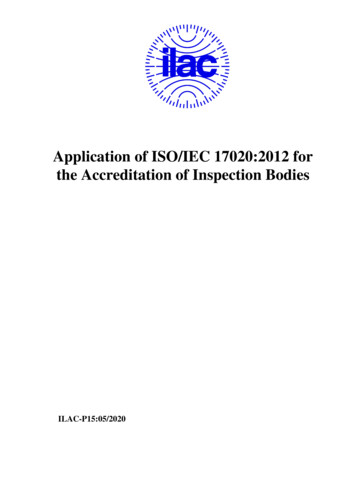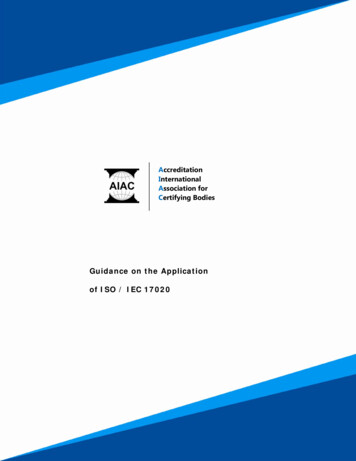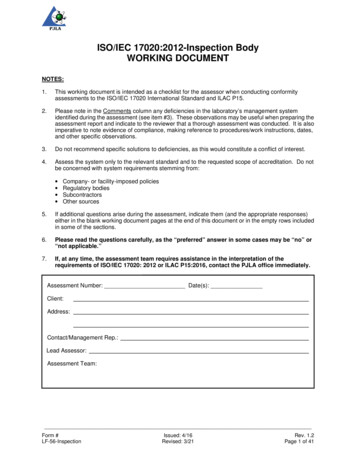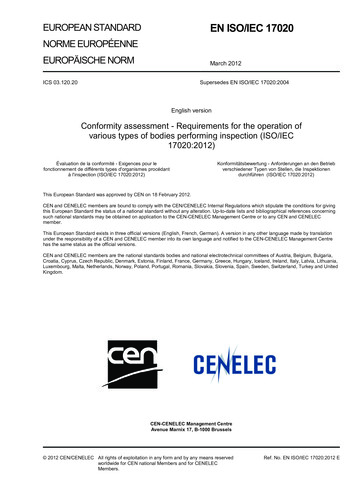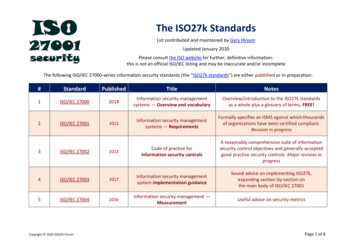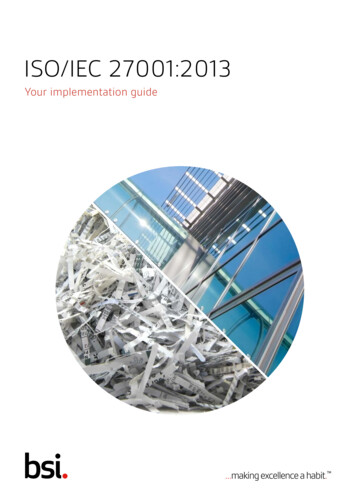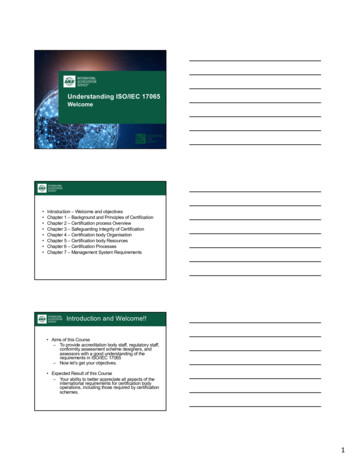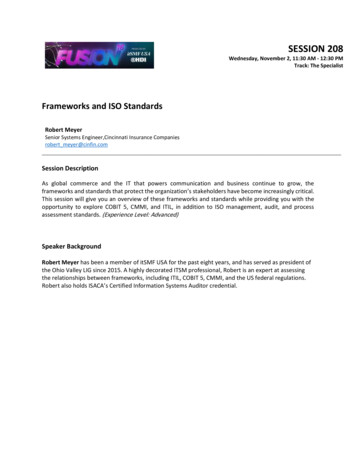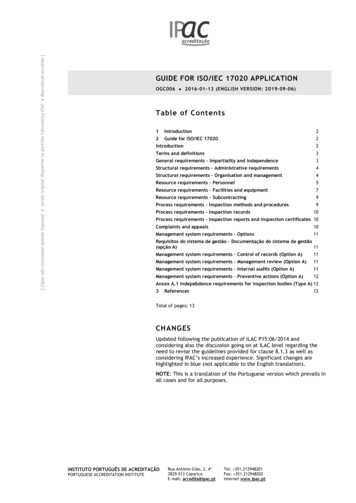
Transcription
Reprodução proibida ]GUIDE FOR ISO/IEC 17020 APPLICATION 2016-01-13 (ENGLISH VERSION: 2019-09-06)versão original disponível na partilha informática IPAC OGC006Table of Contents1Introduction22Guide for ISO/IEC 170202Introduction2Terms and definitions3General requirements – Impartiality and independence3Structural requirements – Administrative requirements4Structural requirements – Organisation and management4Resource requirements – Personnel5Resource requirements – Facilities and equipment7Resource requirements – Subcontracting9Process requirements - Inspection methods and procedures[ Cópia não-controlada quando impressa Process requirements - Inspection records910Process requirements - Inspection reports and inspection certificates 10Complaints and appeals10Management system requirements – Options11Requisitos do sistema de gestão – Documentação do sistema de gestão(opção A)11Management system requirements – Control of records (Option A)11Management system requirements – Management review (Option A)11Management system requirements – Internal audits (Option A)11Management system requirements – Preventive actions (Option A)12Anxex A.1 Indepebdence requirements for inspection bodies (Type A) 123References12Total of pages: 13CHANGESUpdated following the publication of ILAC P15:06/2014 andconsidering also the discussion going on at ILAC level regarding theneed to revise the guidelines provided for clause 8.1.3 as well asconsidering IPAC’s increased experience. Significant changes arehighlighted in blue (not applicable to the English translation).NOTE: This is a translation of the Portuguese version which prevails inall cases and for all purposes.INSTITUTO PORTUGUÊS DE ACREDITAÇÃOPORTUGUESE ACCREDITATION INSTITUTERua António Gião, 2, 4º2829-513 CaparicaE-mail: acredita@ipac.ptTel: 351.212948201Fax: 351.212948202Internet www.ipac.pt1
GUIDE FORISO/IEC 17020APPLICATION[ Cópia não-controlada quando impressa versão original disponível na partilha informática IPAC Reprodução proibida ]OGC0062016-01-131 IntroductionThis document provides guidelines for application of ISO/IEC 17020:2012 Conformity assessment –Requirements for various types of bodies performing inspection operation. It is intended to be used by IPACin inspection bodies assessments as well as by inspection bodies seeking to manage their operations in orderto fulfil accreditation requirements.This document is an adapted version of ILAC P15. IPAC has also included other guidance which, afterconsulting interested parties, has been considered relevant.Each disposition is identified by the corresponding section number of ISO/IEC 17020: 2012 and anappropriate suffix. In the case of guidelines coming from ILAC P15, the identification will be of the type4.1.4a which corresponds to the first ILAC guidance for section 4.1.4 of the standard. In the case of IPACspecific guidelines, the identification will like 5.2.5 IPAC 1, which corresponds to the first IPAC’s guideline forthe clause 5.2.5 of the standard.Translation note: For the reader benefit ILAC P15 dispositionsnot directly transposed by IPAC – either because IPAC doesnot recognize significant added-value to the text in theISO/IEC 17020 or because IPAC introduced more specificand/or elaborated dispositions – are still included in thisEnglish version of OGC006 with the relevant text markedstrikethrough.The term "shall" is used throughout this document to indicate mandatory ISO/IEC 17020:2012 requirements.The term "should" is used in this document to indicate those provisions which, although not mandatory, areindicated as a recognized form of compliance. Inspection bodies whose systems do not follow any guidelinewill only be accredited if they demonstrate to IPAC that their solutions meet, at least in an equivalentmanner, the applicable section of ISO/IEC 17020:2012.An accreditation body shall at all times maintain its impartiality as required by ISO/IEC 17011. However,IPAC is prepared to discuss this guide and its interpretation with any applicant body and, whereappropriate, to respond to requests for clarification (General Accreditation Regulation - DRC001).2 Guide for ISO/IEC 17020IntroductionI. IPAC 1 It is recognized that inspection and product certification definitions overlap.The key issue in determining whether an activity should be considered as an inspection or as a productcertification is the purpose of that activity. Typical differences between inspection and productcertification are described in the table below.TopicPage 2 of 13InspectionProduct CertificationConformity assessmentObjectSingle or small productsseriesLong product series orproduct lotsProduct phaseDesign, production, inservice and aftermodification or repairDesign and productionRelationship betweenassessment object andconformity assessmentbody1st, 2nd and 3rd party3rd partyDecision principleNo separation is neededbetween who makesinspection decision of whoperforms the inspectionsCertification decisions aremade by other people thanthat those performing theassessment.
GUIDE FORISO/IEC 17020APPLICATIONOGC0062016-01-13[ Cópia não-controlada quando impressa versão original disponível na partilha informática IPAC Reprodução proibida ]TopicInspectionProduct CertificationResult of assessmentactivityReport and/or inspectioncertificateProduct certificateActivities to confirm thevalidity of the outcome ofthe conformity assessmentactivityNoneSurveillanceResult validityAt inspection momentUntil certificate expirationor revocation dateMarkingInspected item onlyOn all objects that are partof the same conformityassessment object categoryTerms and definitions3.1a The term “installation” may be defined as “a collection of components assembled to jointly achieve apurpose not achievable by the components separately”.General requirements – Impartiality and independence4.1.3a Risks to the impartiality of the inspection body shall be considered whenever events occur whichmight have a bearing on the impartiality of the inspection body or its personnel.4.1.3b The inspection body should describe any relationships that could affect its impartiality to the extentrelevant, using organisational diagrams or other means.Examples of relationships that could influence the impartiality include:Relationship with a parent organisationRelationships with departments within the same organisationRelationships with related companies or organisationsRelationships with regulatorsRelationships with clientsRelationships of personnelRelationships with the organisations designing, manufacturing, supplying, installing, purchasing,owning, using or maintaining the items inspected4.1.3 IPAC 1 Once that risks to impartiality had been identified it is expected risks not to change; however,any change to the events originally considered shall promptly promote their reassessment.4.1.3 IPAC 2 It may be relevant to have information on personnel working in the inspection body and otherunits or departments (corresponds to ILAC-P15 5.2.4a).4.1.4 IPAC 1 For each impartiality risk, the inspection body should establish whether it has to be eliminatedor minimized. To each identified risk should correspond one (or more) action(s) to eliminate or minimize it.Records of defined actions implementation shall be maintained.4.1.5a Inspection body’s top management should have a documented statement highlighting the body’scommitment to impartiality when performing inspection activities, managing conflict of interest andassuring the objectivity of its inspection activities. Other statements and actions form the top managementshall not contradict that statement.4.2.1 IPAC 1 It is understood that information placed in the public domain is the one whose access is nolonger under the control of the inspection body. It is clarified that the information provided to theregulator, as well as to IPAC, does not fit into that concept. It is understood that the customer agreementrequires that he is explicitly informed and expresses on such matter, except in what concerns access toinformation by the relevant authorities.4.2.2 IPAC 1 It is understood that information provided to the regulatory authority, as well as to IPAC, doesnot require notification to the client.Page 3 of 13
GUIDE FORISO/IEC 17020APPLICATIONOGC0062016-01-13[ Cópia não-controlada quando impressa versão original disponível na partilha informática IPAC Reprodução proibida ]Structural requirements – Administrative requirements5.1.3a The inspection body should describe its activities by defining the general field and range ofinspection (e.g. categories/sub-categories of products, processes, services or installations) and the stage ofinspection, (see note to clause 1 of the standard) and, where applicable, the regulations, standards orspecifications containing the requirements against which the inspection will be performed.5.1.4 IPAC 1 The requirement in the standard implies that the inspection body identifies the responsibilitiesto be covered which in turn requires a risk analysis of the inspection activities as well as the definition ofappropriate provisions.Thus, relevant dispositions should be structured as follows:1. To analyse the risks arising from the inspection activities;2. To assess the potential liabilities associated with identified risks;3. To demonstrate that provisions are consistent with those responsibilities.The inspection body may use external expertise for any of these phases.5.1.4a The level of provisions should be commensurate with the level and nature of liabilities that mayarise from the inspection body’s operations.5.1.4 IPAC 2 In addition to the risks associated with the performance of inspection activities, the inspectionbody shall also consider any legal or regulatory requirements from the economies where the inspectionbody operates.Inspection bodies should also pay special attention to management of liabilities when subcontracting.5.1.4 IPAC 3 Risks can be covered by different provisions. Insurance may, for example, cover employers'liability, civil liability and professional liability.5.1.4 IPAC 4 It is not the role of an accreditation body to approve risks, responsibilities and/or provisionsestablished by the inspection body. The plausibility assessment performed by IPAC does not transfer anyresponsibility to IPAC.Structural requirements – Organisation and management5.2.2a The size, structure, composition and management of an inspection body, taken together, shall besuitable for the competent performance of the activities within the scope for which the inspection body isaccredited.5.2.2b “To maintain the capability to perform the inspection activities” implies that the inspection bodyshall take steps to keep it appropriately informed about applicable technical and/or legislativedevelopments concerning its activities5.2.2c Inspection bodies shall maintain their capability and competence to carry out inspection activitiesperformed infrequently (normally with intervals longer than one year). An inspection body may demonstrateits capability and competence for inspection activities performed infrequently through ‘dummy inspections’and/or through inspection activities conducted on similar products.5.2.3a The inspection body shall maintain an up-to-date organisational chart or documents clearlyindicating the functions and lines of authority for staff within the inspection body. The position of thetechnical manager(s) and the member of management referenced in clause 8.2.3 should be clearly shown inthe chart or documents.5.2.4a It may be relevant to provide information concerning personnel which carry out work tasks for boththe inspection body and for other units and departments.5.2.5a In order to be considered as “available”, the person shall be either employed or otherwisecontracted.5.2.5b In order to ensure that the inspection activities are carried out in accordance with ISO/IEC 17020,the technical manager(s) and any deputy(ies), shall have the technical competence necessary to understandall significant issues involved in the performance of inspection activities.5.2.5IPAC 1The appointment of technical manager(s) appointment shall be documented.5.2.5 IPAC 2 It is recommended to consider factors as below when determining if more than one technicalmanager is necessary: Page 4 of 13The nature of inspections, such as different technical areas, or locations involved;Office opening hours;Impacts of inadequate inspections results;
GUIDE FORISO/IEC 17020APPLICATIONOGC0062016-01-13[ Cópia não-controlada quando impressa versão original disponível na partilha informática IPAC Reprodução proibida ] Consequences of inspection activities cessation.5.2.6a In an organization where the absence of a key person causes the cessation of work, the requirementfor having deputies is not applicable.5.2.6IPAC 1 Deputiesshall have appropriate qualifications for the relevant responsibilities.5.2.7a The position categories involved in inspection activities are inspectors and other positions whichcould have an effect on the management, performance, recording or reporting of inspections.5.2.7b The job description or other documentation shall detail the duties, responsibilities and authoritiesfor each position category referred to in 5.2.7a.Resource requirements – Personnel6.1.1a Where appropriate, inspection bodies shall define and document competence requirements for eachinspection activity, as described in 5.1.3a.6.1.1b For “personnel involved in inspection activities”, see 5.2.7a.6.1.1c Competence requirements should include knowledge of the inspection body’s management systemand ability to implement administrative as well as technical procedures applicable to the activitiesperformed.6.1.1d When professional judgment is needed to determine conformity, this shall be considered whendefining competence requirements.6.1.1 IPAC 1 The competence encompasses the technical knowledge and the practical ability. Depending ofthe area in which the inspection is inserted, t
ISO/IEC 17020 or because IPAC introduced more specific and/or elaborated dispositions – are still included in this English version of OGC006 with the relevant text marked strikethrough. The term "shall" is used throughout this document to indicate mandatory ISO/IEC 17020:2012 requirements. The term "should" is used in this document to indicate those provisions which, although not mandatory .
